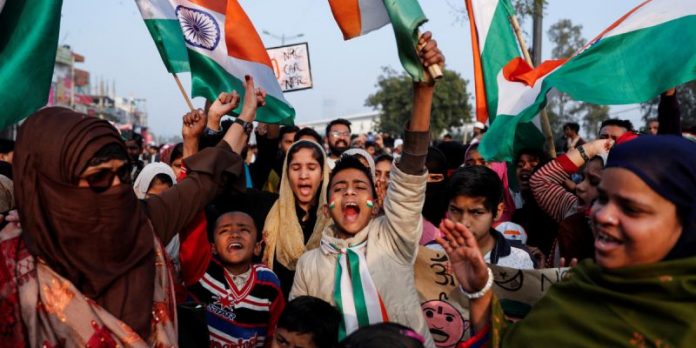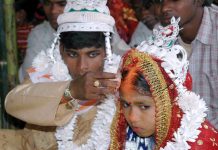The article is written by Naman Sherstra from the Department of Law, University of Calcutta. This article discusses whether the SC notice on limiting the children’s Right to protest is arbitrary or not.
Table of Contents
Introduction
Since the freedom fight of Independence, we have witnessed children accomplishing with their parents in the protests and movements. The picture of “Bapu” can be seen with a child leading him with a stick. Bhagat Singh had led the freedom movement since his early age of 16. The Shaheen Bagh at Delhi witnessed a long going protest of women against the newly passed citizenship law (CAA).
The women were accompanied by their children when a four-month child Jahan died of congestion and cold on 30th January 2019. The Supreme Court, in a letter written by Zen Gunratan Sadavarte, a 12 years old bravery award winner, took suo-moto cognizance on the death of the child and issued the Central and Delhi Government to look into the matter restricting the participation of children in such protests. Recently, we have observed that most of the protests are led by young children. In this article, we will discuss the reasonability of the Supreme Court’s intervention by putting restrictions on the children.
Article 19 and Right to protest
The right to protest is one of the rights provided by the Constitution of India under Article 19. These rights are provided under clause (1) subclause (b) of the article. Article 19 provides such right to peaceful protest to each and every citizen of India. However, after the Constitutional (Sixteenth Amendment) Act 1963, the government restricted the “right to protest” by inserting clause 2 under Article 19 which broadly stated that government has the power to restrict the rights conferred to the citizen under Article 19 of the Constitution by making any kind of law to uphold the sovereignty and integrity of the Indian Territory.
At that time, the Constitutional Amendment Act was brought as the demand of several political groups for secession from India was high. So, the government was in fear that such voices if freely exercised under the Constitution of India can be a threat to the sovereignty and integrity of India. Later, as time passed the government started using the provision as a similar tool to stifle dissenting voices.
Now the question arises that “how can the children accompanying with his/her parents protesting peacefully and for a legitimate reason at Shaheen Bagh can be a threat to the sovereignty or integrity of India?”
“Did the death of a four-month-old child compel the SC to over-cross the constitutional provision and rely upon the prevailing popular morality?” In my opinion, the answer would be “no”. The courts and judges are also bound by the constitutional provisions and the said protest of women along with children prima facie does not attract the restriction as per Article 19(2).
How is the notice antithetical to the rights guaranteed under the Constitution?
The notice served by the apex court not only seems to be contrary to the provisions of Article 19 but it seems a violation of bundles of other rights as provided by the Constitution of India. The other right which is infringed due to the restriction over the protest is the “right to education and development” as provided by the Constitution under Article 21(a). It reads as the state to provide free and compulsory education to the children. S.C has said that the right to life and dignity of a person is not assured till it is accompanied by the right to education. The right to education is an important element for the development of children with freedom and dignity. This argument encompasses the “right to protest” as an encroachment of the right to express an opinion and such limitation certainly restricts the right to expression henceforth preventing them to develop with freedom and dignity. However, it would have been the first time when the apex court has dealt with the scope and liability in the context of children.
The apex court, however, failed to take note of a brutal incident that happened in UP where approx 41 students were subjected to rampant custodial torture in the police stations of Bijnor, Firozabad, Muzzafarnagar, and other districts of Uttar Pradesh. The students were protesting against the CAA. Similarly, in Karnataka’s Bidar district the students of class six were mentally tortured by the police, as the students were presenting their artistic presentations on the citizenship laws. In Lucknow, the Lucknow Child Welfare Committee issued notice to the parents who were protesting along with their children at dharna sites against the CAA, ordering them to take back their children.
The CWC had threatened to take action against the parents if they didn’t comply with the said orders. There are many such incidents where the government exercised its arbitrary power to restrict the “children’s right to protest” and the Supreme Court ignored to intervene in such issues.
The major point to be noted in these incidents are that the equal absence of children is proportionate with the equal absence of their mother after the executive action or on the notice of the apex court. So, such notice has not only restricted the rights of children but the rights of mothers have also ceased in such circumstances.
International laws regulating the children’s right to protest
The Supreme Court’s notice of restricting the rights of children is also contrary to the international laws. The United Nations Convention on Rights of Children under Article 13 which was ratified by India in 1992 recognizes freedom of expression of the child which includes “freedom to seek, receive and impart information and ideas of all kinds” either in writing and reading or any type of artistic representation by the media as the child wants.
So, this Convention provides the rights to peaceful assembly under the ambit of “right to protest” and such right cannot be curtailed exceptionally on the ground of integrity and sovereignty of India. If such a restriction is imposed it needs to pass the test of “reasonableness” as provided by the Constitutional Courts.
“Article 5” of the UNCRC recognizes the “evolving capacities” of the children as to be respected by the states. The evolving capacities mean that the child acquires enhanced competencies and there is a need for them to be protected. The Convention allows for the recognition that children in different environments and cultures, and faced with diverse life experiences, will acquire competencies at different ages. The law recognizes that the children do not acquire agency with attaining the age of 18 but they are capable to exercise their rights what they follow from their guardian at their amateur age. So, the state must facilitate such rights as provided by the Constitution instead of putting a curb on them in the name of the security and integrity of India.
Similarly, Article 13 of the UNCRC states that the State should assure Children’s right to express his/her view which affects the child, in accordance with the age and maturity of the child. It means that the child shall, in particular, be provided with the opportunity to be heard in any judicial and administrative proceedings affecting the child, either directly, or through a representative or an appropriate body, in a manner consistent with the procedural rules of national law.
All above-stated provisions of the UNCRC together recognize the children’s right of expression and provide that the state should assure the proper accessibility of such rights of expression to the children. The reasonability behind restricting such “rights” must satisfy the argument that the exercise of such rights of the children may harm the integrity and security of India. Apparently, the “right to protest” exercised by the children at Shaheen Bagh was not threatening the sovereignty of India.
Neither, any provision of the Constitution nor UNHCR provides the state to curb such rights on the order of the Supreme Court. The apex court including high courts was established to crosscheck violation of any kind of “right” by the executive action so, in the first instance, it seems astonishing that the court has issued the notice to the government to put restriction over the “rights to protest” of children giving the reasonability that such notice was issued on the death of an infant at the said place.
Judgments related to children’s Right to speech and assembly
There are some notable judgments where the courts have recognized the rights of development, expression, and education which was restricted by the government on the court’s order.
In Unnikrishnan vs state of Andhra Pradesh, the Supreme Court has recognized the protection of children’s right to educational opportunities and facilities for children to develop in a healthy manner and in conditions of freedom and dignity under the ambit of Article 21. This right encircles the “right to protest and freedom of expression” as provided under Article 19 of the Constitution of India. Restricting children from expressing their opinion compromise under “right to protest” and arguably curtails their rights to develop with freedom and dignity as recognized by the apex court under Article 21 of the Constitution.
Similarly, in Mohini Jain v State of Karnataka, where a citizen of Uttar Pradesh challenged the step of the Karnataka Government to allow the private medical colleges to increase the exorbitant fee. The Supreme Court of India held that the charging of such kind of fee in the name of “capitation fee” violated the right to education as implied under the right to life and dignity and equal protection of law provided under Article 21 of the Constitution. In order to express constitutional right, the court interpreted the right to education as an important condition for a person ensuring his “right to life with dignity” The court further added that the private institutions acting as an agent of the state have a duty to provide equal and non-discriminatory access to the education to the children.
Protest role in children’s learning
Many schools tell their children to read newspapers and watch news channels to gain knowledge of contemporary issues going across the world. The participation in the protest makes them realize and express their rights as provided by the Constitution of India and observe the discontentment against the prejudiced acts of government which have violent effects on the people’s life. Ahead as the Shaheen Bagh protest was related to the citizenship laws, hailing from the poor class family they would also learn about the citizenship laws.
On the other hand, the protestors living in slums merely possess any kind of citizenship documents, so the snatching away of citizenship rights from their parents shall also affect the rights of children. If the parents will be considered illegal migrants the same will be their children. So, the children must have the right to protest equal to their parents.
Why should children be allowed to protest?
Amidst the CAA/NRC protests, the school children in New Delhi were allowed to protest in cold weather against the pollution and make people aware of the ill effects of such protests and neither the courts nor the quasi-judicial bodies took any kind of note on such protests. On the other hand, the court restricts the children protesting at Shaheen Bagh for their endangered life due to the newly enacted citizenship law. Both incidences show that there must be an equal balance of the court while giving the reasonability of restricting the rights of children. If the cold weather of Delhi was a reason to stop them` then how can the same not be a reason for the school children protesting against pollution.
Second, such restrictions also affect the rights of the mother related to the children as the notice will also affect the mobility of the mother. So, a single restriction over the children ceases the rights of two people which prima-facie seems contrary to the constitutional provisions. The constitutional courts are deemed as the protector of the fundamental rights of the citizens so the apex court needs to reanalyze its order.
Conclusion
The Supreme Court has always protected the rights of the citizens whenever it has been encroached by the government. However, after the Covid-19 pandemic broke up the long time continuing protest has ended on the threat of dispersing of the virus among the protestors but the said notice has set up a different view on the mind of society. The apex court must have considered this issue on the basis of constitutional morality rather than popular morality. It would have set a new “benchmark” for the first time protecting children’s ”right to protest”.
References
- https://ohrh.law.ox.ac.uk/indian-supreme-court-arbitrarily-limits-childrens-right-to-protest/#:~:text=This%20wide%20ban%20is%20arbitrary,parents%20and%20other%20child%20caregivers.
- https://www.thehindu.com/opinion/op-ed/protecting-childrens-right-to-protest/article30846374.ece
LawSikho has created a telegram group for exchanging legal knowledge, referrals and various opportunities. You can click on this link and join:
 Serato DJ Crack 2025Serato DJ PRO Crack
Serato DJ Crack 2025Serato DJ PRO Crack











 Allow notifications
Allow notifications



